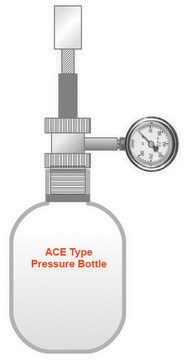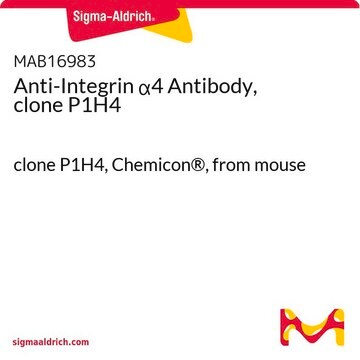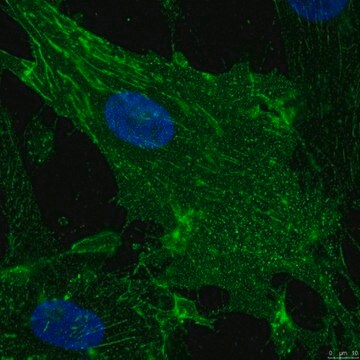General description
We are committed to bringing you greener alternative products, which adhere to one or more of The 12 Principles of Green Chemistry.This antibody is Preservative-free, produced without the harm or sacrifice of animals and exceptionally stable to allow for ambient shipping and storage if needed and thus aligns with "Waste Prevention", "Designing Safer Chemicals" and "Design for Energy Efficiency".
Click here for more information.
ZooMAb® antibodies represent an entirely new generation of recombinant monoclonal antibodies.Each ZooMAb® antibody is manufactured using our proprietary recombinant expression system, purified to homogeneity, and precisely dispensed to produce robust and highly reproducible lot-to-lot consistency. Only top-performing clones are released for use by researchers. Each antibody is validated for high specificity and affinity across multiple applications, including its most commonly used application. ZooMAb® antibodies are reliably available and ready to ship when you need them.
Specificity
Clone 1C21 is a ZooMAb® Rabbit recombinant monoclonal antibody that specifically detects Integrin-a4 (CD49d). It targets an epitope within 18 amino acids from the C-terminal, cytoplasmic domain.
Immunogen
KLH-conjugated linear peptide corresponding to 18 amino acids from the C-terminal, cytoplasmic domain of human.
Application
Quality Control Testing
Evaluated by Western Blotting in MOLT4 cell lysate.
Western Blotting Analysis: A 1:3,000 dilution of this antibody detected Integrin 4/CD49d in MOLT4 cell lysate.
Tested applications
Western Blotting Analysis: A 1:3,000 dilution from a representative lot detected Integrin 4/CD49d in lysates from Jurkat cells and Human peripheral blood mononuclear cells (PBMC)..
Immunohistochemistry (Paraffin) Analysis: A 1:1,000 dilution from a representative lot detected Integrin 4/CD49d in mouse spleen and rat spleen tissue sections.
Immunocytochemistry Analysis: A 1:300 dilution from a representative lot detected Integrin 4/CD49d in Jurkat cells.
Note: Actual optimal working dilutions must be determined by end user as specimens, and experimental conditions may vary with the end user
Target description
Integrin alpha-4 (UniProt: P13612; also known as CD49 antigen-like family member D, Integrin alpha-IV, VLA-4 subunit alpha, CD49d) is encoded by the ITGA4 (also known as CD49D) gene (Gene ID: 3676) in human. Integrins are heterodimers composed of a variable a-subunit of 150-170 kDa and a conserved 95 kDa b subunit. They contain a large extracellular domain responsible for ligand binding, a single transmembrane domain, and a cytoplasmic domain. The exact combination of various a- and b-subunits dictates the binding specificity of integrins to different ECM components. Although both subunits are required for adhesion, the binding specificity primarily depends on the extracellular portion of the a-subunit. Integrins bind to their ligands with a low affinity and this binding occurs only when a certain minimal number of integrins are present at specific points known as focal contacts and hemidesmosomes. In response to specific stimuli, they cluster in focal contacts and their combined affinities create a region on the cell surface, which presents sufficient adhesive capacity to adhere to the ECM. This allows cells to bind to a large numbers of matrix molecules simultaneously while still maintaining their ability to explore their environment without losing all attachments. Integrin a4/CD49d is a single-pass type I membrane glycoprotein that is synthesized with a signal peptide (aa 1-33), which is subsequently cleaved off to produce the mature form that contains a large extracellular domain (aa 34-977), a transmembrane domain (aa 978-1001), and a short cytoplasmic tail (aa 1002-1032). Integrin a4/CD49d plays a critical role in leucocyte trafficking, activation, and survival, and also facilitates interactions between leucocytes and stromal cells found in the marrow or germinal center of lymphoid follicles via VCAM-1 and fibronectin. It also serves as a signaling receptor that influences B-cell survival via upregulation of Bcl-2 family members. CD49d/CD29 and CD49d/Integrin b7 are known to be receptors for fibronectin. They recognize one or more domains within the alternatively spliced CS-1 and CS-5 regions of fibronectin. They also serve as receptors for VCAM1. CD49d/CD29 recognizes the sequence Q-I-D-S in VCAM1. This ZooMAbZooMAb® recombinant monoclonal antibody, generated by our propriety technology, offers significantly enhanced specificity, affinity, reproducibility, and stability over conventional monoclonals. (Ref.: Haile, LA., et al. (2010). J. Immunol. 185(1); 203-210; Shanafelt, TD., et al. (2008). Br. J. Haematol. 140(5); 537-546).
Physical form
Purified recombinant rabbit monoclonal antibody IgG, lyophilized in PBS, 5% Trehalose, normal appearance a coarse or translucent resin. The PBS/trehalose components in the ZooMAb formulation can have the appearance of a semi-solid (bead like gel) after lyophilization. This is a normal phenomenon. Please follow the recommended reconstitution procedure in the data sheet to dissolve the semi-solid, bead-like, gel-appearing material. The resulting antibody solution is completely stable and functional as proven by full functional testing. Contains no biocide or preservatives, such as azide, or any animal by-products. Larger pack sizes provided as multiples of 25 μL.
Reconstitution
300 μg/mL after reconstitution at 25 μL per vial. Please refer to guidance on suggested starting dilutions and/or titers per application and sample type.
Storage and Stability
Recommend storage of lyophilized product at 2-8°C; Before reconstitution, micro-centrifuge vials briefly to spin down material to bottom of the vial; Reconstitute each vial by adding 25 μL of filtered lab grade water or PBS; Reconstituted antibodies can be stored at 2-8°C, or -20°C for long term storage. Avoid repeated freeze-thaws.
Legal Information
ZooMAb is a registered trademark of Merck KGaA, Darmstadt, Germany
Disclaimer
Unless otherwise stated in our catalog or other company documentation accompanying the product(s), our products are intended for research use only and are not to be used for any other purpose, which includes but is not limited to, unauthorized commercial uses, in vitro diagnostic uses, ex vivo or in vivo therapeutic uses or any type of consumption or application to humans or animals.









